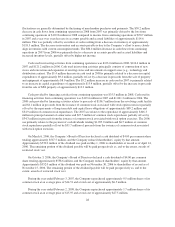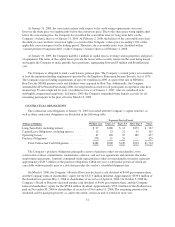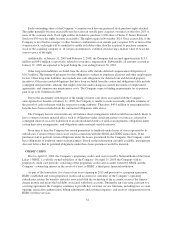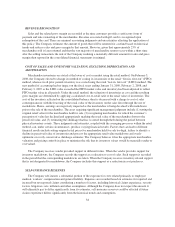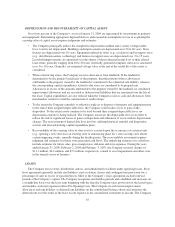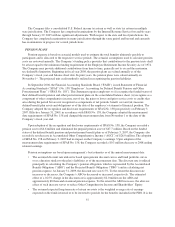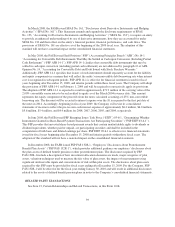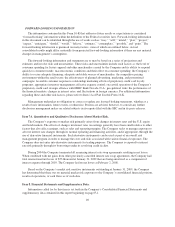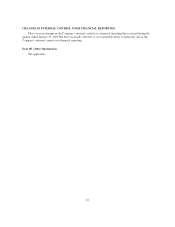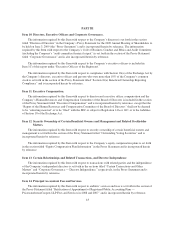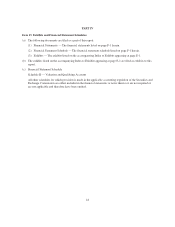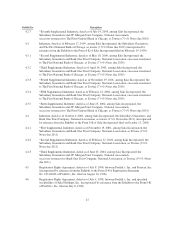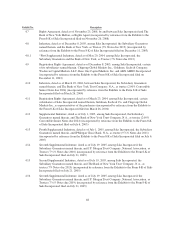Saks Fifth Avenue 2008 Annual Report Download - page 39
Download and view the complete annual report
Please find page 39 of the 2008 Saks Fifth Avenue annual report below. You can navigate through the pages in the report by either clicking on the pages listed below, or by using the keyword search tool below to find specific information within the annual report.Company’s policy to invest approximately 65% of the pension fund assets in equities, 30% in fixed
income securities and 5% in real estate. The Company’s estimate of the expected long-term rate of
return considers the historical returns on plan assets, as well as the future expectations of returns on
classes of assets within the target asset allocation of the plan asset portfolio. This rate is utilized
principally in calculating the expected return on plan assets component of the annual pension expense.
To the extent the actual rate of return on assets realized is greater than the assumed rate, that year’s
annual pension expense is not affected. Rather, this gain reduces future pension expense over a period of
approximately 10 years. To the extent the actual rate of return on assets is less than the assumed rate,
that year’s annual pension expense is likewise not affected. Rather, this loss increases pension expense
over approximately 10 years. The Company’s expected long-term rate of return on assets was 8.0% in
2008 and 2007.
• The assumed average rate of compensation increase is the average annual compensation increase
expected over the remaining employment periods for the participating employees. This rate is estimated
to be 4% for the periods following January 31, 2009 and is utilized principally in calculating the PBO
and annual pension expense. The estimated effect of a 0.25% change in the assumed rate of
compensation increases would not be material to the PBO or annual pension expense.
NEW ACCOUNTING PRONOUNCEMENTS
On February 3, 2008, the Company adopted the provisions of SFAS No. 157, “Fair Value Measurements”
(“SFAS No. 157”), which clarifies the principle that fair value should be based on the assumptions market
participants would use when pricing an asset or a liability and establishes a fair value hierarchy that prioritizes
the information used to develop those assumptions. In February 2008, the FASB amended SFAS No. 157 to
exclude FASB Statement No. 13 “Accounting For Leases” and its related interpretive accounting
pronouncements that address leasing transactions. The FASB also issued a final Staff Position to allow a
one-year deferral of adoption of SFAS No. 157 for nonfinancial assets and nonfinancial liabilities that are
recognized or disclosed at fair value in the financial statements on a non-recurring basis. The Company is in the
process of evaluating the impact of applying SFAS No. 157 to nonfinancial assets and liabilities measured on a
non-recurring basis. The impact of applying SFAS No. 157 to financial assets and liabilities did not have a
material impact on the consolidated financial statements for the year ending January 31, 2009.
In February 2007, the FASB issued SFAS No. 159, “The Fair Value Option for Financial Assets and
Financial Liabilities” (“SFAS No. 159”). SFAS No. 159 permits entities to choose to measure many financial
instruments and certain other items at fair value that currently are not required to be measured at fair value. This
Statement is effective no later than fiscal years beginning on or after November 15, 2007. The Company elected
to continue to record long-term debt at its amortized cost. Accordingly, this standard has no impact on the
consolidated financial statements.
In December 2007, the FASB issued SFAS No. 141R, “Business Combinations” (“SFAS No. 141R”), which
addresses the recognition and accounting for identifiable assets acquired, liabilities assumed, and non-controlling
interests in business combinations. SFAS No. 141R also establishes expanded disclosure requirements for
business combinations. SFAS No. 141R will become effective as of the beginning of the 2009 fiscal year. The
effect of adopting SFAS No. 141R will depend on the circumstances of any potential future acquisitions made by
the Company.
In December 2007, the FASB issued SFAS No. 160, “Noncontrolling Interests in Consolidated Financial
Statements” (“SFAS No. 160”). This standard outlines the accounting and reporting for ownership interest in a
subsidiary held by parties other than the parent. SFAS No. 160 is effective as of the beginning of the 2009 fiscal
year. The adoption of this standard will not have a material impact on the consolidated financial statements.
38


